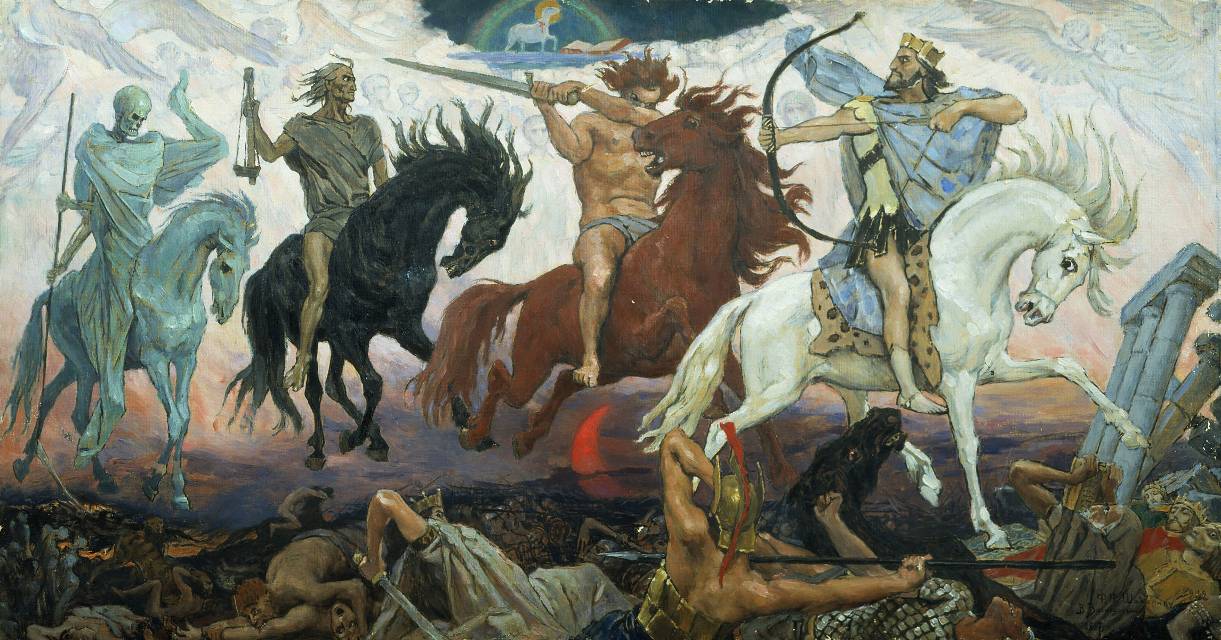
COVID-19 and the 4 horsemen
The Bible consists of the Old and New Testaments. The first book in the Old Testament is Genesis (meaning origin) where we read how God created the universe and mankind. The last book in the New Testament is the Revelation (meaning something told to man by God bringing shock or surprise) or Apocalypse (prophetic writing about the end of the world).
It is fitting that the first book in the bible should be Genesis (creation of the universe) and the last should be Revelation/Apocalypse (end of the world) a description of the signs before the end. If the word used is Revelation, it’s a Catholic bible, if Apocalypse, Protestant. The Revelation was made by John of Patmos (a Greek town). Consisting of visions made in symbolic language which for Christians at the time it was written would have understood but which for non-Christians at that time would be a mystery.
There are many interpretations of the book but the central theme is clear that through Jesus Christ, God will totally defeat all enemies including Satan and will reward the faithful with the blessing of new heaven and a new earth. Until now, there are still disagreements as to the meanings of the visions especially in chapter 6, the four horsemen and chapter 7 dealing with 144,000 persons with seals on their foreheads. Chapter 6 described 4 frightening horsemen. The just seal talks about a rider on a white horse holding a bow and crown depicting conqueror. The second is on a red horse representing war, the third is on a black horse holding a pair of scales represents famine and the fourth is on a pale colored horse representing death. After hundreds of years of debate, the consensus is that people worldwide suffer greatly whenever the 4 horsemen are on the loose trampling and destroying everything on its path. This can be seen in the drawings in the old bibles, the church paintings, frescoes and statues. The concept is clearly shown in the 1918 novel “Los Cuatros Jinetes de Apocalipsis” by Spanish writer Vicente Blasco Ybanez during the first world war (1914-1918). It became a world best seller when Charlotte Brewster made an English translation. Brewster also translated Ybanez’s “Sangre y Arena” into “Blood and Sand” (another bestseller and made into a movie starring Tyrone Power). In the 1920s the silent black and white film “The 4 horsemen of the Apocalypse” with Rudolph Valentino dancing the original Argentine tango was a hit. You can find Ybanez in Wikipedia and the 2 books in English or Spanish in E-books and Z Library.
The 1960s MGM film 4 horsemen of the Apocalypse with Glenn Ford was a disaster. The first rider on the white horse is today accepted by many as representing Pestilence or disease. Some say once the first rider mounts his white horse, the other 3 will not go far behind. The implication though farfetched and purely imaginative, is that with Coronavirus (epidemic) running wide all over the other 3 horsemen will form up sooner or later. Last January 2020 when Coronavirus was horribly creeping all over, some said let’s change February 2020 into December 2020 so that the third month of 2020 which is March 2020 will become January 2021 and the 2020 year of the rat will disappear. Remove the year of the RAT which is from January to December 2020 and the Coronavirus will disappear.
Only one chapter in the book describes how the 4 horsemen stomped on mankind. The Russian scholar refugee befriended by the hero, Julio Desnoyer, was explaining the impact of the Revelation’s 4 horsemen on the First World War when they heard a very loud, wail/cry from a neighbor who learned her husband died in the war. The Russian said now he is sure that the 4 horsemen are indeed on the loose and the world’s agony and suffering will begin. Some say that after the war (red) there will be pestilence (white) and hunger (black) the finale/cleanup will be the rider on the pale horse (death).


No Comments